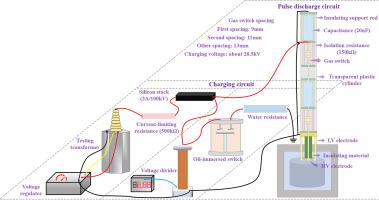Optimization design of the system for rock fragmentation by high-voltage pulsed discharge
IF 4.6
2区 工程技术
Q2 ENGINEERING, CHEMICAL
引用次数: 0
Abstract
Aiming to address the lack of a quantitative analysis in the design of the system for rock fragmentation by high-voltage pulsed discharge (RHPD), an optimization design method for the RHPD system based on medium breakdown characteristics and stress impulse constraints is proposed, and a multi-physical parameter coupling mathematical model based on numerical calculation and circuit simulation is constructed. Considering the drilling condition with a 3 1/2 in. wellbore diameter, the optimal energy parameter of the RHPD system with an 88.9 mm claw-shaped discharge electrode is obtained based on the optimization design model. The optimal energy parameter of the system and the corresponding equivalent capacitance, equivalent charging voltage of the system are 58.75 J, 2.966 nF, and 199.03 kV, respectively. Using these optimal parameters, a RHPD system with a coaxial Marx generator as the topological structure is developed. The rock fragmentation performance of the system is tested in a transformer oil-granite medium. After 180 min, a drilling effect is observed on the granite surface, with a hole diameter of 92.66 mm and a depth of 35.70 mm. The energy consumption per unit volume for fragmentation of the developed system is approximately 967 J/cm3, and the rate of penetration at a 10 Hz pulse discharge frequency is approximately 0.3 m/h. This research provides theoretical guidance for the parameter optimization and structural design of the RHPD system.

高压脉冲放电破岩系统优化设计
针对高压脉冲放电破岩系统设计中缺乏定量分析的问题,提出了一种基于介质击穿特性和应力脉冲约束的高压脉冲放电破岩系统优化设计方法,构建了基于数值计算和电路仿真的多物理参数耦合数学模型。考虑到3 1/2 in的钻井条件。基于优化设计模型,得到了88.9 mm爪形放电电极的RHPD系统的最优能量参数。系统的最佳能量参数为58.75 J,等效电容为2.966 nF,等效充电电压为199.03 kV。利用这些最优参数,开发了以同轴马克思发生器为拓扑结构的RHPD系统。在变压器油-花岗岩介质中测试了该系统的破岩性能。180 min后,花岗岩表面出现钻孔效果,钻孔直径为92.66 mm,深度为35.70 mm。开发的系统单位体积破碎能耗约为967 J/cm3,在10 Hz脉冲放电频率下的穿透速率约为0.3 m/h。该研究为RHPD系统的参数优化和结构设计提供了理论指导。
本文章由计算机程序翻译,如有差异,请以英文原文为准。
求助全文
约1分钟内获得全文
求助全文
来源期刊

Powder Technology
工程技术-工程:化工
CiteScore
9.90
自引率
15.40%
发文量
1047
审稿时长
46 days
期刊介绍:
Powder Technology is an International Journal on the Science and Technology of Wet and Dry Particulate Systems. Powder Technology publishes papers on all aspects of the formation of particles and their characterisation and on the study of systems containing particulate solids. No limitation is imposed on the size of the particles, which may range from nanometre scale, as in pigments or aerosols, to that of mined or quarried materials. The following list of topics is not intended to be comprehensive, but rather to indicate typical subjects which fall within the scope of the journal's interests:
Formation and synthesis of particles by precipitation and other methods.
Modification of particles by agglomeration, coating, comminution and attrition.
Characterisation of the size, shape, surface area, pore structure and strength of particles and agglomerates (including the origins and effects of inter particle forces).
Packing, failure, flow and permeability of assemblies of particles.
Particle-particle interactions and suspension rheology.
Handling and processing operations such as slurry flow, fluidization, pneumatic conveying.
Interactions between particles and their environment, including delivery of particulate products to the body.
Applications of particle technology in production of pharmaceuticals, chemicals, foods, pigments, structural, and functional materials and in environmental and energy related matters.
For materials-oriented contributions we are looking for articles revealing the effect of particle/powder characteristics (size, morphology and composition, in that order) on material performance or functionality and, ideally, comparison to any industrial standard.
 求助内容:
求助内容: 应助结果提醒方式:
应助结果提醒方式:


